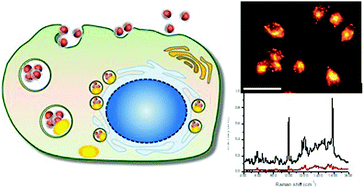Real-time tracking of the autophagy process in living cells using plasmonically enhanced Raman spectroscopy of fucoidan-coated gold nanoparticles†
Abstract
To date, a variety of biological assays such as immunostaining, western blotting, enzyme-linked immunosorbent assay (ELISA), and flow cytometry have been used to analyze and trace important biological events and therapies. In addition to these techniques, the application of microscopic analytical techniques such as matrix-assisted laser desorption/ionization-time of flight (MALDI-ToF) mass spectrometry and Raman spectroscopy is increasing, allowing information to be obtained at the molecular level. In this study, we have conducted real-time tracking of autophagy, a cellular process that has recently been attracting significant attention. To achieve this purpose, we performed Raman spectroscopy on human oral squamous carcinoma cells (HSC3) incubated with bioactive molecule-modified plasmonic gold nanoparticles. The bioactive molecule–nanoparticle complexes were synthesized using fucoidan, a biopolymer that induces autophagy. By using this platform, it was possible to trace the entire autophagic process successively from cell introduction to autophagic apoptosis. This fusion of nanocomposites and spectroscopic techniques is expected to enable more complex biological processes to be pursued at the molecular level in the future.

- This article is part of the themed collection: Materials and Nano Research in Atlanta


 Please wait while we load your content...
Please wait while we load your content...